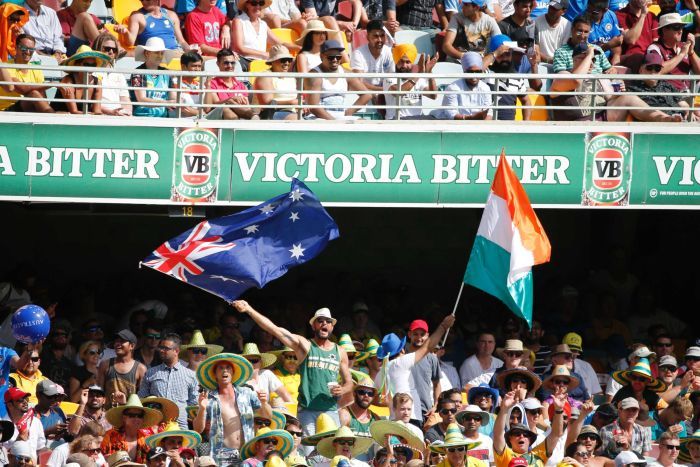Australian, Indian celebrations 'will ring hollow until women's rights are respected'
Updated
 Photo:
Though they symbolise different things, both Australia Day and Indian Republic Day are timely to consider the national identity of each nation. (AAP: Glenn Hunt, file)
Photo:
Though they symbolise different things, both Australia Day and Indian Republic Day are timely to consider the national identity of each nation. (AAP: Glenn Hunt, file)
For me, a second generation Indian Australian, today provides two reasons to reflect on my dual heritage: it's Australia Day and Indian Republic Day.
One marks the arrival of the British in Australia, and the other signifies the end of British rule in India.
Though they symbolise different things, both days are timely to consider the national identity of each nation.
We as a democratic nation have a colonial history and a deep Indigenous history.
The red and yellow colours on the Aboriginal flag represent their strong connection with the sun and the land. On the Australian flag, there is a Union Jack and a cluster of five stars which comprises the constellation of the Southern Cross. In fact, the word 'Australia' means 'Southern'.
On the Indian flag, the green represents the fertility and growth of the land, the saffron colour indicates the strength and courage of the country, and the white signifies peace and truth.
Strong ties to land, mateship and giving each other a 'fair go' are some core Australian values. Some key Indian values include Ahimsa (non-violence), Shakti (strength) and Satya (truth).
Over the past 60 years, Australia's population has more than doubled.
Presently, almost half the population is either born overseas or has a parent born overseas.
This is a unique opportunity for Australians of different nationalities to integrate and to contribute to the Australian way of life.
Just as distinct and colourful spices create a good Indian curry, it is the mosaic of cultural diversity that enriches Australia.
The diverse backgrounds of almost half the Australian population can enrich Australia, if these resources are adequately tapped into.
There are ongoing debates about changing the date of Australia Day, but regardless of the date, we can't deny our past. By accepting it we acknowledge a part of who we are.
Australia Day is a day to celebrate what is good about being Australian and to reflect on how we can improve, and the same applies to Indian Republic Day.
Both countries have room for improvement in women's equality
It is critically important to consider the treatment of women, who constitute more than half the Australian population and a significant proportion of the Indian population.
On the one hand, we can celebrate the ascendancy of a diverse women - our first female Liberal Premier of NSW from an Armenian background, Gladys Berejiklian MP.
In addition, Ken Wyatt MP is the first Indigenous person to be promoted to the federal ministry as Minister for Aged Care and Indigenous Health.
They are shining examples of multicultural success stories.
India and Australia have each had a female prime minister and the 'Motherland' has seen some progress in relation to women.
For the first time since it was established in 1986, the Australia-India Business Council has a female national chair, Sheba Nandkeolyar.
As treasurer, a significant number of government board appointments that Premier Berejiklian made were women based on merit.
Women's participation on boards has also increased. However, women hold only one in five directorships in NSW-based ASX companies. Men hold the majority of leadership roles in the workplace, even in female-dominated industries.
In India, there has been a fall in women's labour participation rate, and ongoing concerns in relation to the safety of women. Violence against women continues to be a significant problem in Australia and India.
As a former treasurer who has outlined one of her key priorities to be a strong economy, I'm optimistic that Premier Berejiklian will recognise the importance of addressing sex discrimination and the under-representation of women in leadership positions (and I prefer to focus on her approach to policy rather than her marital status or whether she has any children).
There are significant economic arguments for increasing women's participation. According to the Australian Treasury 2015 Intergenerational Report, a 4 per cent increase in female participation would result in Australia's GDP being $25 billion higher than it was in 2015.
It is important to be aware of the subtle forms of sex discrimination and economic exploitation that have become more apparent over the past decade.
I know of cases in which hardworking women have felt compelled to leave their jobs to avoid harassment and/or discrimination. They chose not to challenge their employers as they feared their power in the industry and the ramifications of challenging them.
Such women are in the precarious position of having to courageously stand up for themselves, while simultaneously losing a vital source of independence and resilience.
We have a rich Indigenous heritage and colonial roots, from which emerged the democracy we live in today.
If we are truly to give each other a 'fair go', we must recognise that discrimination against women is everyone's problem.
Irrespective of the date it's held on, I can't fully celebrate Australia Day or Indian Republic Day until men and women actively and whole-heartedly respect and stand up for each other.
Pallavi Sinha is a lawyer, lecturer and speaker. She is on the 2016 AFR & Westpac 100 Women of Influence Award winner list, and is an award winner for Excellence in Law, Journalism & Community Services. She serves on the White Ribbon Reference Group.
Topics: australia-day, women, race-relations, australia, india
First posted








